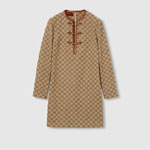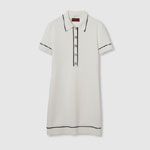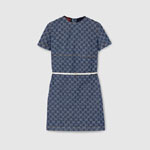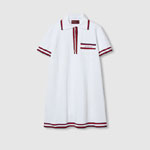Gucci's Dress Series: Where Heritage Meets Avant-Garde
Design Aesthetics: The Alchemy of Timeless Codes
Gucci's latest dress collection reimagines archival motifs with a razor-sharp contemporary edge. The Gucci Polo Dress With Web Trim In Ivory And Red exemplifies this philosophy, reviving the house's equestrian legacy through its signature crimson-and-ecru web stripe - a nod to 1950s luggage trims - while the polo collar adds sporty irreverence. Meanwhile, the GG Wool Jacquard Mini Dress transforms the iconic double-G logo into a hypnotic textile narrative, its geometric repetition evoking both retro glamour and digital-age maximalism.
This season's gucci floral clothing techniques deserve particular attention: delicate embroidery on silk georgette shifts mimics watercolor brushstrokes, proving Alessandro Michele's departure hasn't dimmed the brand's romantic sensibility. The genius lies in balancing such ornate details with clean silhouettes - a masterclass in controlled decadence.
Styling Playbook: From Boardroom to Nightfall
For power lunches, layer the GG Jacquard mini dress under a structured blazer, accessorized with horsebit loafers and a Jackie 1961 bag. Transition to evening by shedding the jacket and adding crystal-embellished tights - a trick stolen from Milan's fashion insiders.
The polo dress shines at garden parties when paired with platform wedges and gucci mane clothing-inspired chunky gold chains, blending prep-school nostalgia with hip-hop swagger. Those exploring yupoo clothes gucci for inspiration will note how streetwear enthusiasts are hacking these pieces: try belting the ivory-red dress over baggy jeans for a Milan-meets-Brooklyn vibe.
Legacy in Motion: Writing the Next Chapter
While some seek cheap gucci clothes replicas, true connoisseurs recognize the value embedded in these designs. Each web trim honors artisanal workshops that have crafted Gucci's leather goods since the 1940s, while the jacquard looms used for GG-patterned fabrics remain unchanged since Tom Ford's 1995 revival. Yet the brand keeps one eye firmly on the future - note how the polo dress's A-line cut aligns with Gen Z's mod-inspired resurgence.
In this collection, Gucci doesn't merely dress bodies; it armors them in centuries of craftsmanship and tomorrow's cultural forecasts. The message is clear: tradition isn't a cage, but a springboard for revolutions.








